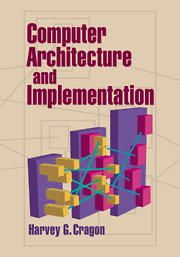3 - USER INSTRUCTION SET DESIGN
Published online by Cambridge University Press: 05 June 2012
Summary
INTRODUCTION
Over the past four decades of computer design and development, significant attention has been paid to the design of the processor instruction sets or the instruction set architecture (ISA), also known as the machine language. During the early period, starting with von Neumann, designers focused primarily on the design of instructions that supported the user or application program. Three developments then expanded this focus to the instruction support of operating systems, virtual memory systems, and multiprocessors, covered in Chapter 8. Each of these expanded capabilities has been considered to be invisible to the user programmer. For efficient and logically correct implementations and use, these support instructions usually operate in a protected mode not available to the user.
Because computers are general-purpose machines, functions can be provided by programming that are not available in the ISA. An example is the use of a subroutine to provide floating-point operations and data types. Functions and data types that are provided in the ISA are called architected, and functions and data types provided by programming are called programmed.
Instruction sets of early computers were designed in an environment of few resources. The memory was small, requiring that the instructions be as dense as possible. The resources for performing operations were likewise limited, leading to primitive instruction sets that would be recognized today as reduced instruction set computers. The von Neumann ISA contained only 21 instructions.
- Type
- Chapter
- Information
- Computer Architecture and Implementation , pp. 50 - 130Publisher: Cambridge University PressPrint publication year: 2000

